Introduction: This month the southern conservation area showed a marked decrease in the number of cases reported
Introduction:
This month the southern conservation area showed a marked decrease in the number of cases reported. This could be attributed to the increased surveillance within the area. During the month a combined team of Kenyan and Tanzania rangers performed a joint operation to ensure reduction of poaching cases. The veterinary team also carried out an aerial recce within the park and surrounding ecosystem. The DSWT provided an aircraft for this activity.
The purpose of this exercise was for the following: - See the distribution of wildlife within the park -Check for injured/sick animals within the park -Check for any unnoticed carcasses within the park and its surrounding ecosystem -Check for any unusual activities or happenings within the park and the surrounding ecosystem. No unusual sighting was seen except for one elephant carcass which was spotted.
Case #1 Post Mortem Report of an adult elephant:
Date: 10th September 2014
Species: Elephant
Sex: Female
Age: 30-35 years
Location: Irimito-Amboseli National Park
History:
An elephant carcass was seen on 08-09-2014 at day time around 10.00 a.m by pilots overflying the area.
General post mortem findings:
- The elephant had been lying on a bare ground for about three weeks.
- Both elephant tusks were missing indicating human involvement.
- The carcass had been mauled by scavengers.
- There was also a penetrating wound on the dorsal side of the carcass around the abdominal area (approx. 5cm diameter) leading to the suspicion of a spear injury prior to death.
Cause of death:
Suspected spear injury most likely by poachers.

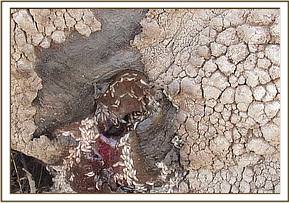


Case # 2 Giraffe case:
Date: 11th September 2014
Species: Giraffe Sex: Male Age: Adult
Location: Engong Narok – Amboseli Ecosystem
History:
A male giraffe was spotted by rangers and reported to have been lame within the community land. They reported to the veterinary team who attended to the case immediately for examination and treatment.
Immobilization: The giraffe was recumbent and immobile on arrival at the scene. Immobilization was therefore not necessary for examination and assessment.
Examination: On physical examination the giraffe had suffered from an open compound and comminuted fracture (left hind limb) at the hip joint. A decision to euthanize the giraffe was made since as the prognosis was poor. An incision into the fracture was made to expose the extent of the injury. Bone fragments were retrieved from the hip joint. The giraffe could have suffered from a fall which led to the severe dislocation and fracture.
Prognosis: The prognosis was poor and chances of recovery even with clinical intervention were nil and therefore the giraffe had to be sadly euthanized.
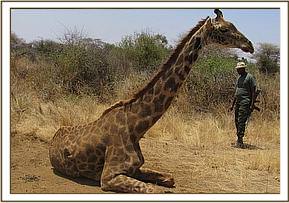
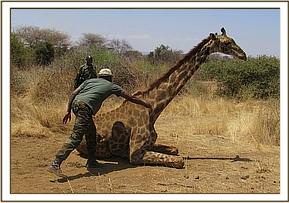
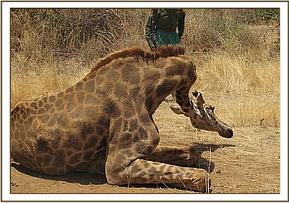
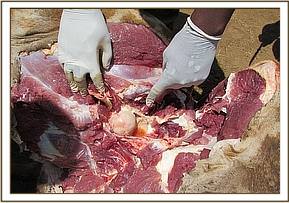
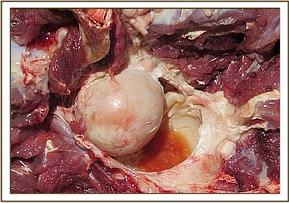

Case #3 Treatment of injured elephant:
Date: 17th September 2014
Species: Elephant
Sex: Male
Age: 30-35 years
Location: Tangorngoro (Amboseli Ecosystem) GPS Co-Ordinates:37 m 0315883 Utm 9737728 History:
A male elephant was reported to be lame and having an injury on the left hind limb. The elephant had been previously collared. The elephant proved difficult to locate and dart him using a vehicle and therefore foot darting was done. The lameness was assessed and a decision to immobilize the elephant was made.
Immobilization: The elephant was immobilized using 18 mgs Etorphine Hydrochloride in a 3cc dart toped up using water for injection. Foot darting was done using Dan-inject system due to the thick Vegetation. The elephant stood still and after effects of the narcotics took place, he dashed into the thick bush. The team followed the elephant tracks and full immobilization took place after 17 minutes. The elephant was finally located safe and sound after a 1.5 hrs search. The trunk was maintained patent using a piece of stick placed across the nostril entrances. The temperature was high hence plenty of water was doused on the elephant to keep the body temperatures low. The ears were used as blindfold.
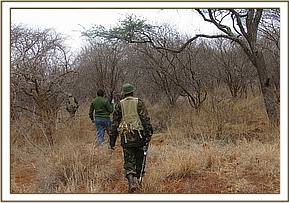
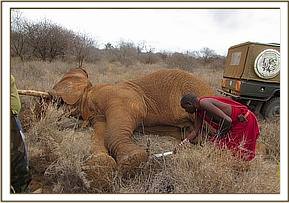

Examination and Treatment: On physical examination the elephant had a huge swelling on the left hind and fore limb. No physical injury was visible leadin to a suspicion that he could have had a fall. The elephant was then injected with 100 ml Betamox L.A and 100 ml Flunixine meglumine at different sites intramuscularly. The entire operation lasted about 30 minutes.
Reversal of immobilization: Diprenorphine Hydrochloride (54mgs) into the ear vein was used. It took about 10 minutes to be fully awake and walk away.
Prognosis:
Good.
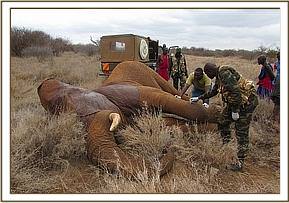
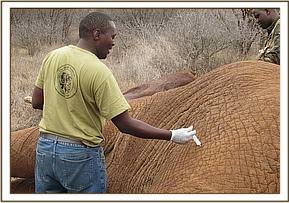

Case #4 Treatment of injured elephant:
Date: 10th August 2014 & Successive repeat treatments on 19th September and 26th September 2014
Species: Elephant
Sex: Male
Age: 25-35 years
Location: Satao Elerai ( Amboseli Ecosystem)
History:
The big life game scouts reported a case of an injured male elephant to the S.C.M.V.U based at the Amboseli. The veterinary team immediately attended to the case and made a decision to dart the elephant for examination and treatment.
Immobilization: The elephant was immobilized using 16 mgs Etorphine Hydrochloride in a 3cc dart toped up using water for injection. Foot darting was done using the Dan Inject system due to the rough terrain. The elephant went down on lateral recumbence. The trunk was maintained patent using a piece of stick placed across the nostril entrances. The temperature was high hence plenty of water was doused on the elephant to keep the body temperatures low. The ears were used as blindfold.
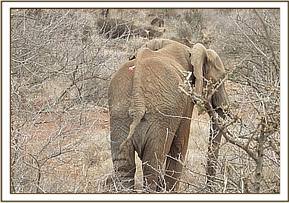
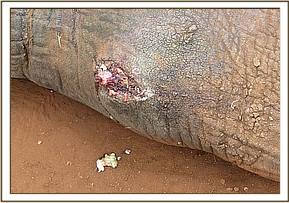

Examination and Treatment: On physical examination the elephant had a swollen left hind limb and wounds around the limb. The wounds were septic and had necrotic tissue. An incision was made to allow access and drainage of pus from the wound. The wounds were likely to have been caused by a gun shot. The dead tissue was derided and removed. The wound was then thoroughly cleaned using water and Hydrogen Peroxide. It was then lavaged using tincture of Iodine. Topical antibiotic cream and green clay was then applied into the wound to facilitate healing and avoid infection. The elephant was then injected with 100 ml Betamox L.A and 100 ml Dexamethasone at different sites intramuscularly. The entire operation lasted about 25 minutes.
Repeat treatments:
A repeat treatment was carried out on 26-9-14. However during the repeat treatment the elephant was treated with 4 vials clindamycin each time to take care of bone infection. During the review the elephant showed signs of great improvement.
Reversal of immobilization: Diprenorphine Hydrochloride (48mgs) into the ear vein was used. It took about 7 minutes to be fully awake.

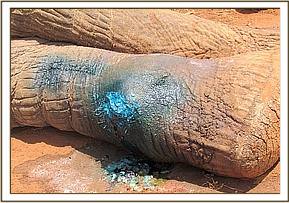

Case #5 Treatment of injured elephant:
Date: 23rd September 2014
Species: Elephant
Sex: Male
Age: 40- 45 years
Location: Satao Tsavo East National Park
History:
The DSWT pilot reported a case of two injured male elephants to the S.C.M.V.U based at the Amboseli. N.P and immediately made plans to airlift the veterinary doctor and rangers to Satao. Plans had been made earlier to have the DSWT helicopter on sight for easy sighting and darting. On arrival, the elephant was in a bush thicket but relatively easy to dart using the helicopter.
Immobilization: The elephant was immobilized using 18 mgs Etorphine Hydrochloride in a 3cc dart toped up using water for injection. Darting was done using the Dan Inject system and was relatively easy from a helicopter despite the thick vegetation. The elephant went down on lateral recumbence. The trunk was maintained patent using a piece of stick placed across the nostril entrances. The temperature was high hence plenty of water was doused on the elephant to keep the body temperatures low. The ears were used as blindfold.
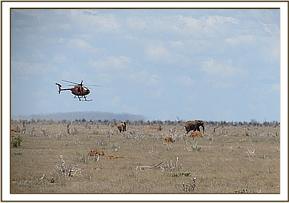


Examination and Treatment: On physical examination the elephant had an approximately 8 cm long wound (1-2 weeks old) on the left flank region but close to the hip region. The wound was septic and had necrotic tissue. An incision was made distal to the wound where there was a pus pocket to allow access and drainage of pus from the wound. The wound is likely to have been caused by an arrow head which had come off with time. The dead tissue was debrided and removed. The wound was then thoroughly cleaned using water and Hydrogen Peroxide. It was then lavaged using tincture of Iodine. Topical antibiotic cream and green clay was then applied into the wound to facilitate healing and avoid infection. The elephant was then injected with 100 ml Betamox L.A and 100 ml Dexamethasone at different sites intramuscularly. The entire operation lasted about 30 minutes.
Reversal of immobilization:
Diprenorphine Hydrochloride (54mgs) into the ear vein was used. It took about 6 minutes to be fully awake from anesthesia.



Case #6 Treatment of injured elephant:
Date: 23rd September 2014
Species: Elephant
Sex: Male
Age: 30 -35 years
Location: Satao Tsavo East National Park
Immobilization:
The elephant was immobilized using 18 mgs Etorphine Hydrochloride in a 3cc dart toped up using water for injection. Darting was done using the Dan Inject system from a helicopter and was relatively easy from a helicopter despite the thick vegetation. The trunk was maintained patent using a piece of stick placed across the nostril entrances. The temperature was high hence plenty of water was doused on the elephant to keep the body temperatures low. The ears were used as blindfold.
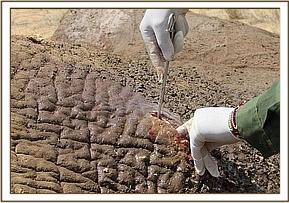


Examination and Treatment: On physical examination the elephant had 2 swellings on the right flank region but close to the hip region. An incision was made distal to the swellings to allow access and drainage of pus from the pus filled wounds. The wound is likely to have been caused by the entry and exit points of an arrow. The dead tissue in the wound was debrided and removed. The wound was then thoroughly cleaned using water and Hydrogen Peroxide. It was then lavaged using tincture of Iodine. Topical antibiotic cream and green clay was then applied into the wound to facilitate healing and avoid infection. The elephant was then injected with 100 ml Betamox L.A and 100 ml Dexamethasone at different sites intramuscularly. The entire operation lasted about 20 minutes.
Reversal of immobilization: Diprenorphine Hydrochloride (54mgs) into the ear vein was used. It took about 6 minutes to be fully awake from anesthesia.
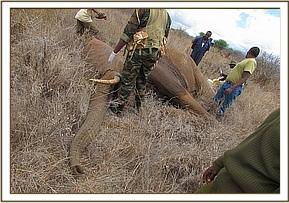
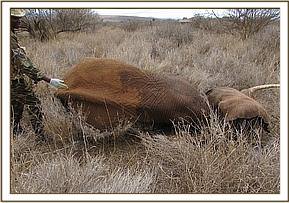

Case #7 Elephant Collaring report:
Date: 24th September 2014
Species: Elephant Matriarch
Sex: Male Age: Adult
Location: Amboseli National Park
History:
This elephant bull had previously been collared but the transmitter had failed transmitting for a considerable period of time. It was therefore necessary to place the collar well.
Immobilization: Etorphine Hcl (0.98%) (M99®) (Norvatis South Africa (Pty) Ltd) 18mg, in a 3 ml Dan - inject dart was prepared. Darting from vehicle was done using a Dan inject® dart rifle (Dan-inject APS, Sellerup Skovvej, Denmark) the elephant was darted and was fully immobilized after 17 minutes. It took 30 minutes to place the collar in properly. Management The elephant was also injected with the following: 1) Oxytetracycline 30000mg (Adamycin® LA 300 Assia Animal Health Ltd, Kenya) I.M 2) Dexamethasone 80mg (Dexajet® Dawa Ltd, Kenya) I.M

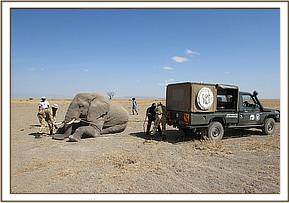

Animal care during anesthesia: The elephant was doused with plenty of water and its eye was covered with the pinna of the ear.
Reversal of anesthesia: This was done using 54mg of diprenorphine Hcl (Norvatis South Africa (Pty) Limited) given IV at the ear vein the animal was reversed from anesthesia, (a ¼ of the dose was given i.m). Recovery from anesthesia was smooth and took about 4 minutes. The elephant stood up and walked away.
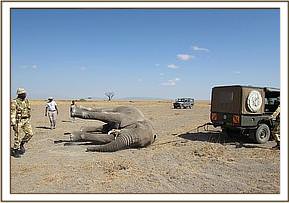
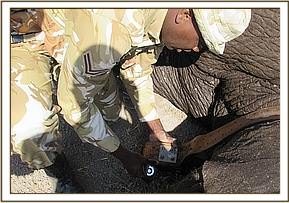

Thanks to:
The Southern Conservation Area Mobile Veterinary Unit is grateful to all individuals and organisations that played a role in assisting us towards achieving our goal. Many thanks to The David Sheldrick Wildlife Trust, The Samuel J and Ethel Lefrak charitable trust and The Kenya Wildlife Service for their continued support to this unit which aims at immediate response to clinical intervention, wildlife rescues and alleviating wildlife suffering.
Report by: Dr. Michael Njoroge.